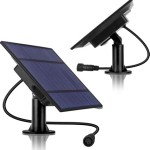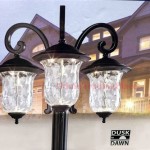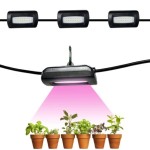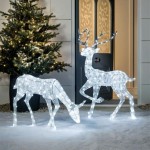Best Wattage For Outdoor Porch Lights
Determining the ideal wattage for outdoor porch lights involves a careful consideration of various factors. The selection process is not simply about maximizing brightness; it encompasses security, aesthetics, energy efficiency, and the overall purpose of the lighting. Proper wattage selection ensures the porch is adequately illuminated without causing excessive glare or unnecessary energy consumption. This article explores the key considerations and provides guidance on choosing the appropriate wattage for different porch lighting scenarios.
The primary function of porch lighting is to provide visibility and security. A well-lit porch deters potential intruders and allows residents and visitors to navigate the area safely, especially during nighttime hours. However, the level of illumination needed for security purposes can vary depending on the surrounding environment. In areas with high crime rates, brighter lighting is often preferred as a deterrent. Conversely, in quieter, more secure neighborhoods, a softer, more ambient light may suffice.
Aesthetics also play a significant role in selecting porch lighting wattage. The appearance of the porch and the overall ambiance of the home can be significantly influenced by the light's intensity and color temperature. Wattage affects the overall brightness, while the light bulb type (e.g., LED, incandescent, halogen) influences the color temperature (measured in Kelvin). Warmer color temperatures (around 2700K-3000K) create a cozy and inviting atmosphere, while cooler temperatures (4000K-5000K) offer a brighter, more modern feel. The choice depends on the desired aesthetic and the architectural style of the house.
Energy efficiency is another crucial consideration. Higher wattage bulbs consume more energy, leading to higher electricity bills and a greater environmental impact. Switching to lower wattage LED bulbs can significantly reduce energy consumption while maintaining adequate brightness. For example, an LED bulb with a lower wattage can provide comparable brightness to a higher wattage incandescent bulb, resulting in substantial energy savings over the long term. The long lifespan of LED bulbs also reduces the frequency of replacements, further contributing to cost savings.
Understanding Lumens and Wattage
Historically, wattage was the primary indicator of a light bulb's brightness. However, with the advent of more energy-efficient lighting technologies like LEDs, lumens have become a more accurate measure of brightness. Lumens represent the total amount of visible light emitted by a light source. Therefore, when selecting porch lighting, it is crucial to focus on the lumen output rather than solely relying on wattage. For instance, a 60-watt incandescent bulb produces approximately 800 lumens, whereas an LED bulb can produce the same amount of light with only 8-12 watts.
To effectively understand the relationship between wattage and lumens, it's essential to consider the specific type of bulb being used. Incandescent bulbs are the least energy-efficient, converting a significant portion of the energy into heat rather than light. Halogen bulbs are slightly more efficient than incandescent bulbs, but still consume more energy than LEDs. Compact fluorescent lamps (CFLs) offer improved energy efficiency compared to incandescent and halogen bulbs, but LEDs are the most energy-efficient option available. LEDs convert a much higher percentage of energy into light, resulting in lower wattage requirements for the same lumen output.
When replacing incandescent bulbs with LEDs, a simple conversion chart can be used to determine the appropriate LED wattage. For example, to replace a 60-watt incandescent bulb, an 8-12 watt LED bulb would typically suffice. Similarly, to replace a 75-watt incandescent bulb, a 10-15 watt LED bulb would be an adequate replacement. It is always advisable to check the lumen output of the LED bulb to ensure it meets the desired brightness level for the porch area.
Factors Influencing Wattage Selection
The size of the porch is a primary factor in determining the required wattage. A larger porch will naturally require more light to achieve adequate illumination compared to a smaller porch. For smaller porches, a single light fixture with a lower wattage bulb (e.g., 40-60 watt equivalent LED) may be sufficient. For larger porches, multiple light fixtures or a single fixture with a higher wattage bulb (e.g., 75-100 watt equivalent LED) may be necessary to ensure even distribution of light and adequate visibility.
The color of the porch and surrounding surfaces also affects the perceived brightness. Darker surfaces absorb more light, requiring higher wattage bulbs to achieve the same level of illumination compared to lighter surfaces that reflect more light. If the porch has dark-colored walls, flooring, or furniture, consider using higher wattage bulbs or increasing the number of light fixtures to compensate for the light absorption. Conversely, if the porch has light-colored surfaces, lower wattage bulbs may be sufficient.
The presence of surrounding ambient light also influences the wattage requirements. If the porch is located in an area with significant ambient light from streetlights or neighboring properties, a lower wattage bulb may be adequate. However, if the porch is located in a darker area with minimal ambient light, a higher wattage bulb will be necessary to provide sufficient illumination for security and visibility. Consider the amount of natural and artificial light present in the surrounding environment when selecting the appropriate wattage for the porch lighting.
The type of light fixture also plays a role. Some fixtures may have limitations on the maximum wattage allowed due to safety and heat dissipation concerns. Always check the manufacturer's specifications for the maximum wattage rating of the light fixture before installing a bulb. Using a bulb with a wattage exceeding the fixture's rating can pose a fire hazard. Moreover, the design of the fixture can influence the light distribution. Fixtures with opaque shades or reflectors may require higher wattage bulbs to compensate for the light obstruction.
Wattage Recommendations for Different Porch Lighting Scenarios
For general porch lighting used primarily for ambient illumination and creating a welcoming atmosphere, a 40-60 watt equivalent LED bulb (approximately 450-800 lumens) is often sufficient. This wattage provides a soft, warm glow that enhances the curb appeal of the home without being overly bright. Consider using dimmer switches with these bulbs to adjust the brightness as needed, creating a more versatile lighting solution.
For security lighting, a higher wattage bulb is generally recommended to provide greater visibility and deter potential intruders. A 75-100 watt equivalent LED bulb (approximately 800-1100 lumens) is a suitable choice for security purposes. Consider using motion sensor-activated lights for security lighting, as they only illuminate the porch when movement is detected, conserving energy and drawing attention to any activity in the area.
For porch lighting used for specific tasks, such as reading or outdoor dining, a brighter light source may be required. A 100-watt or higher equivalent LED bulb (approximately 1100 lumens or more) can provide ample illumination for these activities. Consider using adjustable light fixtures or task lighting with focused beams to provide directed light where it is needed most.
In conclusion, selecting the best wattage for outdoor porch lights requires a comprehensive assessment of various factors, including security needs, aesthetic preferences, energy efficiency goals, porch size, surrounding ambient light, and the type of light fixture being used. Focusing on lumen output rather than solely relying on wattage is crucial, especially when using energy-efficient LED bulbs. Careful consideration of these factors will ensure that the porch is adequately illuminated, providing a safe, welcoming, and energy-efficient environment.

How Many Lumens Outdoor Landscape Lights Need To Work Well

Choose The Best Color Temperature For Your Outdoor Lighting Knowledge Base Super Bright Leds

Led Flood Lights What You Need To Know

How Many Lumens Are Needed For Outdoor Lighting The Home Depot

What Is The Best Wattage For Outdoor Lighting

Outdoor Lighting Guide Lowe S

How Many Lumens Are Needed For Outdoor Lighting The Home Depot

Everything To Know About Bulbs For Landscape Lighting

What Wattage Is Best For Outdoor Flood Lights Ledmyplace

This Is The Best Wattage For Outdoor Lights Around Homes
Related Posts







